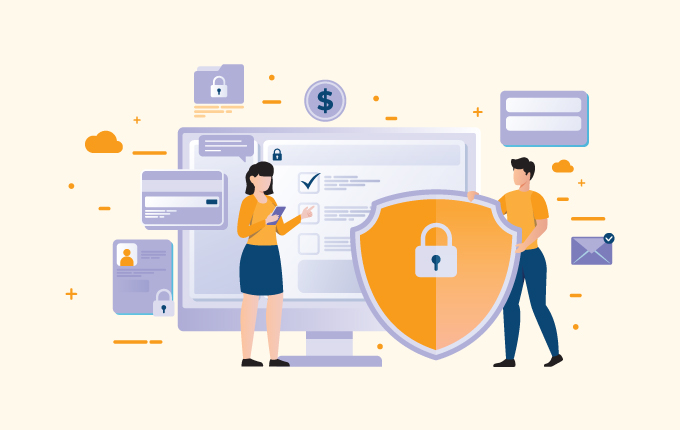Business IntelligenceIT Consulting & StrategySecurityTech Support & Managed IT ServicesConstructionEducationFinanceHealthcareLegalNon-ProfitsReal EstateStartups
As more and more businesses embrace the work-from-home approach, there’s a new need to help those who can understand what a good home office looks like.

When you’re going to work every day, you don’t think too much about how things are set up. You might notice that your keyboard doesn’t work or your chair is a bit uncomfortable, but beyond details like that, you probably don’t think about your office setup much.
With work from home, all that changes. Your team is more responsible for their home office than they ever were for their in-house supplies. That’s why it’s important to make sure everyone knows what the key parts of your home office are, including software, hardware, and security.
These are your home office must-haves
Working from home means thinking about the details of your setup in a way you’re probably not used to (especially the technical elements). This list should help make sure that you’ve got everything you need to not only do your job, but do it safely from home.
Equipment
Making sure you have the physical things you need to do your job is a big part of working from home. This includes obvious things like a computer, but also covers a few not-so-obvious items.
You’re probably going to need a printer at least once in a while for work. Along with printing, these often double as scanners, so if your job involves a lot of signing documents or making up physical copies of documents, you’ll need this scanner.
A good webcam and microphone are also critical, since you’ll be spending a good deal of time in video calls and meetings. Investing in quality microphones and webcams means you’ll be spending less time dealing with quality issues (like wondering why people can’t hear you). You’ll be able to keep focused on efficient meetings, instead.
Internet connection
You’ll probably need a slightly better (if not much better) internet connection than you already have. Latency (the delay that can come with remote video calls) is a productivity killer. The faster and stronger your connection is, the better. You can take this one step further and make sure that you’re wired in, rather than relying on a wireless connection. This greatly reduces issues with latency or dropped connections that can sometimes plague remote workers.
If you’re not sure if your setup is good, talk to either your IT department or internet provider (just be aware that your provider may try to sell you a more robust connection than you need).
Software
Here’s where things can either be really easy or really challenging. You need to make sure that whatever computer you’re working with has all the tools you need to get the job done effectively. You want to make sure that you have tools you’ll use for:
- Video conferencing (Zoom, Meet)
- Communications (Slack, Teams, Hangouts)
- Word processing (Word, Google Docs)
- Spreadsheets (Excel, Sheets)
These tools (and more) can be cloud-based (which makes them super easy to use from anywhere) or they can be proprietary tools that have been installed on the system. Ideally, cloud-based makes the most sense. All your team needs is a computer to access everything. This removes a lot of the maintenance, like updating and patches, that come with more traditional platforms, as well as providing folks the ability to easily do their jobs from anywhere with a computer.
Security
The need for security is probably stronger with home offices than it is with folks who are working in-house. This is largely due to the fact that rather than being on a secure network inside the office, employees are working from home networks that aren’t secure. And, to make things more complicated, it’s not just one home network. It’s dozens, basically one for every remote employee.
The good news is that it’s not impossible to secure these connections. You just need to take a few extra steps to ensure that everything is protected. The big one is making sure that everyone is using virtual private networks (VPNs). These are tools that basically act as a secure pipeline to your business network. They ensure that everything that passes between the remote computer and the company servers are encrypted and as secure as possible.
Security monitoring is also a critical part of keeping your data secure. Monitoring helps you catch problems as soon as they happen. It’s easier to solve smaller problems, like catching someone as soon as they enter your network, rather than waiting until they’ve infected everything or stolen company data.
You should also take the time to train staff about what a security threat, like phishing, looks like. This is critical because employees can be a little more distracted by the world around them in a WFH setting, with everything from loud cafes to children being a normal part of their workday. All it takes is one moment where someone isn’t fully focused on what they’re doing to accidentally click the wrong link. Training can help people understand what a phishing email (or smishing attempt) looks like. If you have the time, take this one step further by including phishing drills where security experts send off fake phishing emails to help reinforce what employees have learned.
Finally, physical security needs to be addressed. Some of these are simple and (hopefully) obvious things, like don’t leave your work computer unattended in a public place. But, there are also details like using privacy screens for laptops while you’re working as well.
Even if people are always working from their home office, security needs to be covered in as much detail as possible.
Furniture
Believe it or not, furniture is a big part of the home office experience. You’re not going to be working well if you’re not comfortable. It’s almost expected that office furniture is awkward or broken, but in a WFH setting, it doesn’t have to be.
Make sure that you’re using desks and chairs that are comfortable, adjustable to the correct height, and that support your body. Not only does this help reduce the risk of injury and strain on your body, but it helps you stay focused because you’re not thinking about how much your back hurts or how sore your wrist is getting from using a mouse.
Need help getting set up?
Making sure that everyone has what they need for a successful WFH office setup can be a challenge. We’re here to make it easier for you. We can help with all your technology needs, from connectivity to security training, and everything in between.
If you’d like to find out more about how we can help you, contact us today.


 July 6, 2022
July 6, 2022 Homefield IT
Homefield IT

